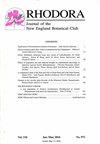美国麻萨诸塞州一种已建立的麻麻属(麻麻科)
IF 0.2
4区 生物学
Q4 PLANT SCIENCES
引用次数: 0
摘要
Nuphar advena (Ait)河中的小岛。f.(睡莲科)在新英格兰以南的美国东部水域常见和广泛分布,有四个公认的亚种(Padgett 2007)。在美国东北部的出现代表了更广泛的,典型的亚种(亚种)。advena [Padgett 2007])。在新英格兰,这个分类群被列为2级保护关注,区域稀有(Brumback和Gerke 2013),目前在康涅狄格州(被认为已经灭绝)和缅因州(康涅狄格州能源和环境保护部2015;缅因州自然区域计划2021)。缅因州的出现代表了该物种高度脱节的种群(Padgett 2007)。作为水生植物鉴定课程的一部分,提交了一份收集,其中包含马萨诸塞州的一种不寻常的Nuphar标本,最初确定为本地N. variegata Dur。叶片具有圆形叶柄和分散的基部裂片,这些特征与斑叶草不一致。为了评估这种特殊的种群,我们在接下来的季节访问了采集地点。在该水体中生长的植物根据叶柄呈圆柱状,叶片露出水面(约60 ~ 60 cm),裂片高度分散的特征(图1),确定为白面草(N. advena)。同样与白面草一致的是,最内层的萼片正面呈绿色。这些植物,以前不知道存在于马萨诸塞州,生长在蓝山保护区蓝山水库(42.22855,−71.05067)的南岸。新发现的马萨诸塞种群已经建立,个体数量丰富,而且体型都非常健壮。在观察的时候,植物正在开花,结出了成熟的果实。它们表现出淡水潮汐水域典型的叶片习性,叶片垂直定位,与直立的叶柄平行。我们不知道这些物种是如何到达水库的,但该遗址的历史强烈表明,这是一次经过深思熟虑的引入。蓝山水库最初建于20世纪50年代。从2007年到2010年,作为储水项目的一部分,马萨诸塞州水资源管理局对其进行了全面重建,该项目消除了原有水库的东半部(马萨诸塞州水资源管理局,2009年)。对2007-2008年(谷歌Earth Pro 2022)卫星图像的回顾显示,该盆地在建设期间是干燥的。该地区被提议重新种植植被,作为该项目场地增强活动的一部分(马萨诸塞州水资源管理局)本文章由计算机程序翻译,如有差异,请以英文原文为准。
An established Nuphar advena (Nymphaeaceae) in Massachusetts, U.S.A.
Nuphar advena (Ait.) Ait. f. (Nymphaeaceae) is common and widespread in waters of the eastern United States south of New England with four recognized subspecies (Padgett 2007). Occurrences in the northeastern United States represent the more widespread, typical subspecies (subsp. advena [Padgett 2007]). In New England, this taxon is of conservation concern as Division 2, Regionally Rare (Brumback and Gerke 2013) and currently state-listed as Special Concern in Connecticut (believed extirpated) and Maine (Connecticut Department of Energy and Environmental Protection 2015; Maine Natural Areas Program 2021). Maine occurrences represent highly disjunct populations for the species (Padgett 2007). As part of an aquatic plant identification course, a collection was submitted which contained an unusual Nuphar specimen for Massachusetts, initially identified as the native N. variegata Dur. The leaf had a rounded petiole and divergent basal lobes— features which do not align with N. variegata. To assess the peculiar population, we visited the collection site the following season. Plants growing in this waterbody were determined to be N. advena based on terete petioles and emersed blades (>60 cm above water surface) with greatly divergent lobes (Figure 1). Also consistent with N. advena, the innermost sepals were green on their adaxial surfaces. These plants, previously not known to exist in Massachusetts, were growing throughout the southern shore of the Blue Hills Reservoir (42.22855, −71.05067) in the Blue Hills Reservation. The newly discovered Massachusetts population is well-established, individuals abundant, and all notably robust in size. At the time of observation, plants were flowering and possessed mature fruits. They exhibited the leaf habit typical of freshwater tidal waters with leaf blades positioned in a vertical orientation, parallel with the erect petioles. How the species reached the reservoir is unknown to us, but the history of the site strongly suggests a deliberate introduction. The Blue Hills Reservoir was initially constructed in the 1950s. From 2007–2010, it was completely reconstructed by the Massachusetts Water Resources Authority as part of a water storage project which eliminated the eastern half of the original reservoir (Massachusetts Water Resources Authority 2009). A review of satellite imagery from 2007–2008 (Google Earth Pro 2022) showed the basin was dry during construction. The area was proposed to be re-vegetated as part of the site-enhancement activities of the project (Massachusetts Water Resources Authority
求助全文
通过发布文献求助,成功后即可免费获取论文全文。
去求助
来源期刊

Rhodora
生物-植物科学
CiteScore
0.40
自引率
0.00%
发文量
40
审稿时长
>12 weeks
期刊介绍:
This peer-reviewed journal is devoted primarily to the botany of North America and accepts scientific papers and notes relating to the systematics, floristics, ecology, paleobotany, or conservation biology of this or floristically related regions.
 求助内容:
求助内容: 应助结果提醒方式:
应助结果提醒方式:


